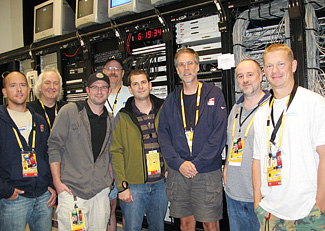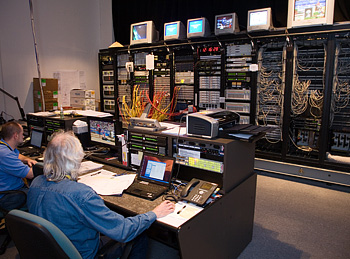NBC Future-Proofs Communications
BEIJING
For NBC, the 2008 Summer Olympics in Beijing saw a record number of programming hours, a record number of audio and video feeds, the minimal use of mobile television trucks and a large portion of production done back home in the United States. The NBC Communications Department knew what it was up against and came to China well prepared.
A little more than a year before the 2008 Olympic games, Bob Gilmartin, Willie Yau of Telex, and I laid out the groundwork for a brand new Communications RIB (rack-in-a-box, NBC slang for its portable Olympics infrastructure). It had been eight years since the original RIB was built, and with the rapid changes in technology, we were able to cut the footprint of the system down from 20 racks of equipment to just 10 while maintaining room for future expansion. This allowed the second half of the RIB to be repurposed for use by other departments.
Redesigning the Comms RIB gave us the opportunity to address some of the shortcomings of the old RIB while embracing new technology and new methodologies. This RIB would be the NBC communications backbone for the next three Olympics so it had to be flexible, adaptable and most importantly, future proof.

The NBC Comms team: (from left) Kevin Shea, Bob Gilmartin, Rickey Hayes, Chuck Roberts of Telex, Comms Manager John Pastore, Jeff Baker, Sean McKinnon of Kerr Vayne Systems and Tony Kremer.WORKING THE TELEX
A lot of the technologies in place that made this all possible came from Telex. The heart of the Comms RIB is a three-frame, dual bus expanded ADAM matrix consisting of 384 AIO ports and 184 RVON ports. In addition, four RVON IOs, five city wide long range RF PLs and IFBs, 20 TIF-2000 and 36 TIF-4000 telephone interfaces allowed NBC to interface with more than a dozen venues, many of which produced live or live-to-tape programming simultaneously around the clock, day and night.
This is in addition to the 200 intercom users at the IBC (International Broadcast Center) working with two independent production studios and control rooms. Most of the connectivity between venues and the IBC Comms RIB was handled via RVON, Telex's voice-over-IP protocol. Venues were equipped with one or more, 8-port RVON IO interfaces allowing remote KP-32 intercom panels connected to the IBC intercom system to be used at Producer, Director and AD positions within venues. These panels were interfaced with the venue intercom panels allowing the operator to talk and listen to both local and remote panels via one headset. In addition to remote intercom panels, 4-wire party lines, IFBs, backup audio and mix-minus are interfaced between venues and the IBC via RVON IO.
Many of the venues connected to the IBC used Telex ADAM and Cronus intercom systems. These systems allowed us to pass the local communication data from their Master Controller through the RVON IO and back to the IBC, giving us the option to monitor and control the venue's intercom system via AZedit, the primary programming interface for the intercom. This is a major time-saving option in that it allowed us to fix a large portion of intercom problems remotely without ever leaving the IBC.
In addition, with the use of an Ethernet Master Controller installed in the IBC system and the fact that each of the venues have Ethernet connectivity between themselves and the IBC, if the IBC were to be evacuated for any reason, its intercom system could be programmed and operated remotely.
We had more remote intercom presence at venues than we have ever had in the past. Thankfully we had Tony Kremer along with the assistance of Telex tech, Chuck Roberts heading up the venue integration and installation. They were responsible for making sure each venue got what it needed.
WHAT THEY WANT

Inside the communications backbone Venues aren't the only local facilities that had to interface with the IBC. Both NBC News and "The Today Show" had a presence in Beijing and required communications with the IBC and venues. In addition, many channels in the United States including CNBC, USA, MSNBC, Bravo, SINO TV, Access Hollywood and Telemundo needed to communicate with venues and the IBC.
Once again, RVON came to the rescue—we used RVON trunking between NBC's home base at 30 Rockefeller Center in New York City and the IBC. Forty RVON ports were utilized as intelligent trunks between three ADAM systems housed at 30 Rock and the IBC system. This allowed the IBC and any of the remote intercom panels attached to it including those installed at venues to communicate point-point with just about anyone involved with the Olympics at 30 Rock. With the exorbitant number of program hours being produced in the United States, and the coordination required between 30 Rock and Beijing to make this all happen, trunking proved to be a life saver.
Outside of the 40 RVON trunks to NY, the IBC allocated 30 RVON ports to interface party lines between the IBC and 30 Rock, Telemundo (in Florida), Englwood Cliffs N.J., and NBC Burbank. These are used mostly for intercom conferencing between many of the aforementioned facilities while reserving the trunking ports for point-point communications. In addition, both NBC News and the Today Show in Bejing shared intercom ports between themselves and the IBC via RVON and fiber optic.
With so much of the state-side communications to Beijing relying on IT, it was important that a backup plan be in place in case of data failure between 30 Rock and the IBC. This was accomplished by using TIF-2000 telephone hybrids linked to RVON party lines that dialed into New York and could make an almost seamless transition if RVON were to ever fail.
As you can imagine, a system of this size and complexity requires some serious programming and maintaining from day to day. Fortunately, we had some of the best guys in the business handling it. Olympics veterans Bob Gilmartin, Jeff Baker and Sean McKinnon along with Rickey Hayes Jr., Kevin Shea and myself were responsible for making all of this happen. The level of precision and professionalism exhibited by the team is unmatched, and the operation could not have been the success it was without the team.
Get the TV Tech Newsletter
The professional video industry's #1 source for news, trends and product and tech information. Sign up below.
